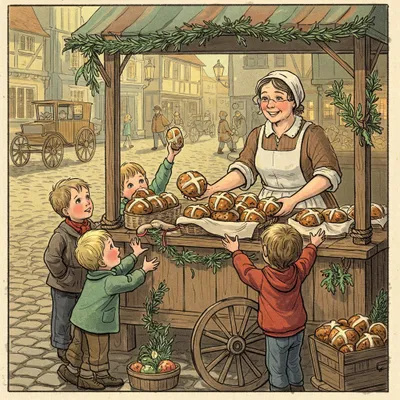Hot Cross Buns

Lyrics
Hot cross buns!
One a penny, two a penny,
Hot cross buns!
If you have no daughters,
Give them to your sons.
One a penny, two a penny,
Hot cross buns!
History and Meaning
"Hot Cross Buns" began unmistakably as a street vendor's cry in 18th-century London—one of history's earliest commercial jingles. The earliest documented version appears in Poor Robin's Almanack for 1733: "Good Friday comes this month, the old woman runs, with one a penny, two a penny, hot cross buns..." The "one a penny, two a penny" phrasing directly reflected vendors' pricing structure for different sizes or qualities of buns.
The product itself carries deep religious significance. Hot cross buns were traditionally baked for Good Friday to commemorate the crucifixion, with their cross marking, spices, and sometimes bitter orange peel symbolizing various aspects of Christ's suffering. The powerful religious associations led Queen Elizabeth I in 1592 to restrict their sale to specific holy days, pushing their production into private kitchens.
An extraordinary wealth of folklore surrounded Good Friday buns. They were believed to never spoil, to possess healing powers, to protect homes from fire, to safeguard sailors from shipwreck, and to guarantee friendship between those who shared them. The tradition at London's Widow's Son pub, where buns are collected annually, preserves this rich folklore to the present day.